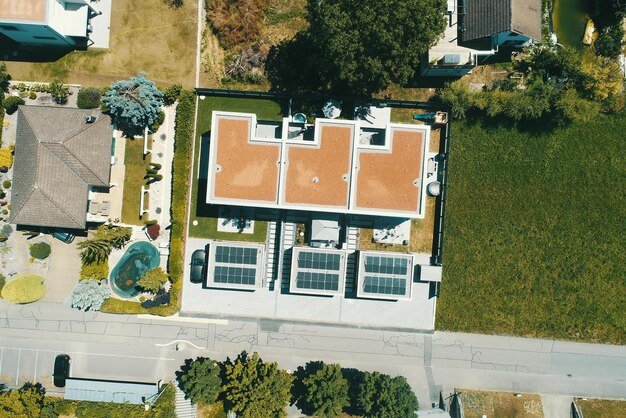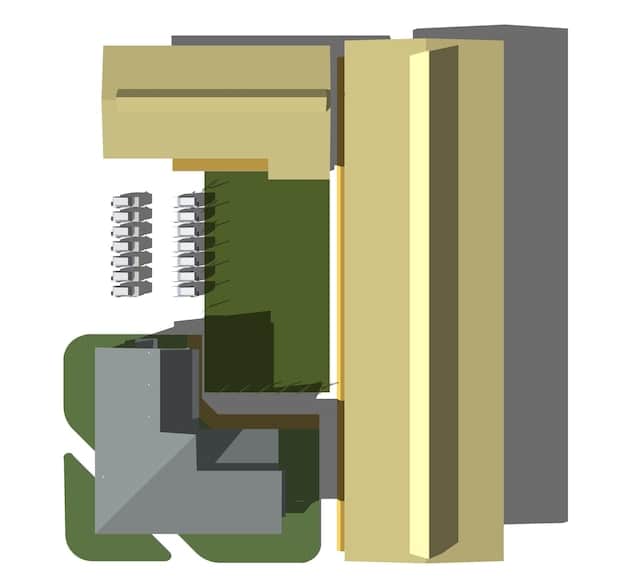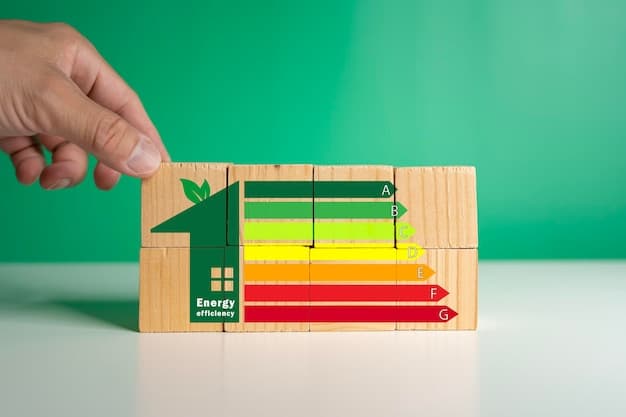Geothermal Heating: Is It Worth the Investment? Long-Term Savings in the US

Geothermal heating offers significant long-term energy savings in the US by harnessing the Earth’s stable underground temperatures, but the initial investment can be substantial, requiring careful evaluation of costs, benefits, and suitability for your specific property.
Are you considering geothermal heating: is it worth the investment for long-term energy savings? This technology taps into the Earth’s natural heat to provide efficient and sustainable heating and cooling solutions. Let’s delve into the pros and cons to help you decide if it is the right choice for your home in the US.
Understanding Geothermal Heating Systems
Geothermal heating systems utilize the consistent temperature of the Earth to heat and cool buildings. Unlike traditional methods, this technology relies on a renewable energy source, offering potential long-term savings and environmental benefits.
How Geothermal Heating Works
Geothermal systems circulate a fluid through underground pipes to absorb or release heat. In winter, the fluid absorbs heat from the warmer ground and transfers it into the building. In summer, the process is reversed, with the fluid carrying heat away from the building and releasing it into the cooler ground. This cycle provides consistent and efficient temperature control year-round.
Types of Geothermal Systems
There are primarily three types of geothermal systems: vertical, horizontal, and pond/lake systems. Vertical systems require drilling deep into the ground, which is suitable for properties with limited land. Horizontal systems involve burying pipes in trenches, making them ideal for larger properties. Pond/lake systems use a nearby body of water as a heat source or sink.
- Vertical Geothermal Systems: Ideal for properties with limited space, these systems drill deep into the earth to access stable temperatures.
- Horizontal Geothermal Systems: Suited for properties with ample land, these systems bury pipes horizontally in trenches.
- Pond/Lake Geothermal Systems: Utilize a nearby body of water as a heat source or sink, providing an efficient and cost-effective solution where available.
Understanding these fundamental aspects of geothermal heating is crucial for assessing its feasibility and potential benefits for your home. Selecting the right type of system depends on your property’s characteristics and specific heating and cooling needs.

The Initial Investment: Costs and Factors
The upfront cost of installing a geothermal heating system is a significant consideration for many homeowners. These costs encompass equipment, installation, and any necessary site preparation. However, it’s essential to view this as a long-term investment rather than just an expense.
Equipment and Installation Costs
The cost of geothermal equipment varies based on the system type, size, and brand. Installation costs depend on factors like the complexity of the project, soil conditions, and labor rates in your area. On average, a geothermal system installation can range from $20,000 to $40,000 in the US.
Factors Affecting Installation Costs
Several factors can influence the overall cost of geothermal installation. The type of system (vertical, horizontal, or pond/lake), the depth of drilling, soil composition, and the distance from the heat pump to the ground loop all play a role. Additionally, any necessary upgrades to your home’s ductwork or electrical system can add to the expense.
Consider these points when assessing the initial investment required for a geothermal system:
- System Type: Vertical systems are typically more expensive due to the need for deep drilling.
- Property Size and Layout: Larger properties may require more extensive ground loops, increasing costs.
- Soil Conditions: Rocky or difficult soil can increase drilling and installation time.
Evaluating these cost factors helps in making an informed decision about whether geothermal heating is a financially viable option for your home. While the initial investment may be higher than traditional systems, the long-term savings and environmental benefits can make it worthwhile.
Long-Term Energy Savings and Benefits
One of the most compelling reasons to invest in geothermal heating is the potential for significant long-term energy savings. These systems are far more efficient than traditional heating and cooling methods, translating into lower utility bills and a reduced carbon footprint.
Energy Efficiency Compared to Traditional Systems
Geothermal systems boast a higher energy efficiency rating compared to conventional furnaces and air conditioners. They operate using a small amount of electricity to circulate heat, rather than burning fossil fuels to generate it. This leads to substantial savings on energy costs over time. In fact, geothermal systems can be up to 400% efficient, meaning they deliver four units of energy for every one unit of electricity consumed.
Reduced Utility Bills and Environmental Impact
Homeowners who switch to geothermal heating often see a significant reduction in their monthly utility bills. The savings can be particularly noticeable during peak heating and cooling seasons. In addition to cost savings, geothermal systems have a minimal environmental impact, as they do not rely on fossil fuels and produce fewer greenhouse gas emissions. This makes them a sustainable choice for environmentally conscious homeowners in the US.
Here are some of the long-term benefits of geothermal heating:
- Lower Energy Bills: Significant savings on monthly heating and cooling costs.
- Reduced Carbon Footprint: Environmentally friendly operation with minimal emissions.
- Increased Home Value: Geothermal systems can enhance the resale value of your property.
By understanding the long-term energy savings and environmental benefits, you can better assess the overall value of investing in geothermal heating. These advantages, combined with potential government incentives and rebates, make geothermal systems an attractive option for homeowners.

Federal and State Incentives for Geothermal Heating
To encourage the adoption of renewable energy technologies, both the federal and state governments offer various incentives for geothermal heating systems. These incentives can significantly reduce the initial investment cost and make geothermal heating more accessible to homeowners.
Federal Tax Credits and Rebates
The federal government provides tax credits for homeowners who install qualified geothermal systems. These credits can cover a percentage of the installation costs, providing a substantial financial benefit. Additionally, some states offer rebates and grants to further reduce the upfront expenses associated with geothermal heating.
State-Specific Programs and Financial Assistance
Many states have their own programs designed to promote geothermal energy. These may include additional tax credits, rebates, or low-interest loans. The availability and specific details of these programs vary by state, so it’s essential to research the incentives offered in your area. Checking with your local energy office or consulting with a geothermal system installer can provide valuable information on state-specific financial assistance.
Here are some key incentives to look for:
- Federal Tax Credits: Credits for a percentage of the total installation costs.
- State Rebates: Cash rebates that can offset the initial investment.
- Low-Interest Loans: Financial assistance to spread out the cost of installation over time.
Taking advantage of these federal and state incentives can make geothermal heating a more affordable option for homeowners. By reducing the initial investment, these programs help to accelerate the payback period and increase the overall return on investment.
Maintenance and Lifespan of Geothermal Systems
Understanding the maintenance requirements and lifespan of geothermal systems is crucial for evaluating their long-term value. While geothermal systems are known for their durability and reliability, proper maintenance is essential to ensure optimal performance and longevity.
Routine Maintenance Requirements
Geothermal systems require minimal routine maintenance compared to traditional heating and cooling systems. Regular checks of the heat pump, air filters, and ground loop components are typically sufficient. Professional maintenance should be scheduled every few years to ensure the system is operating efficiently.
Expected Lifespan and System Longevity
Geothermal systems are designed to last for several decades, with the underground components often having a lifespan of 50 years or more. The heat pump unit typically lasts for 20-25 years with proper maintenance. This longevity contributes to the overall cost-effectiveness of geothermal heating over the long term.
Here are some tips for maximizing the lifespan of your geothermal system:
- Regular Inspections: Schedule professional inspections every 3-5 years.
- Filter Replacement: Replace air filters regularly to maintain air quality and system efficiency.
- System Monitoring: Monitor the system’s performance and address any issues promptly.
Investing in geothermal heating means investing in a durable and long-lasting solution for your home. With minimal maintenance and a lifespan that far exceeds traditional systems, geothermal heating offers a reliable and sustainable alternative.
Making the Decision: Is Geothermal Heating Right for You?
Deciding whether geothermal heating is the right choice for your home involves carefully weighing the costs, benefits, and specific circumstances of your property. While the initial investment can be significant, the long-term energy savings, environmental benefits, and potential incentives make geothermal heating an attractive option for many homeowners in the US.
Factors to Consider Before Investing
Before making a decision, consider factors such as your budget, the size and layout of your property, soil conditions, and access to nearby bodies of water. It’s also essential to research available federal and state incentives and consult with experienced geothermal system installers to obtain accurate cost estimates and system design recommendations.
Assessing Your Home’s Suitability
Not all homes are equally suited for geothermal heating. Older homes may require upgrades to ductwork or insulation to maximize the system’s efficiency. A thorough energy audit can help you assess your home’s suitability and identify any necessary improvements. Evaluating these factors ensures that you can fully realize the benefits of geothermal heating.
Here are key considerations to keep in mind:
- Budget: Evaluate the upfront costs and long-term savings.
- Property Assessment: Assess your home’s suitability and potential upgrade needs.
- Incentives: Research available federal and state incentives.
By carefully considering these factors and conducting thorough research, you can make an informed decision about whether geothermal heating is the right investment for your home. Weigh the costs against the long-term benefits and potential savings to determine if geothermal heating aligns with your energy efficiency goals. Ultimately, geothermal heating offers a sustainable and cost-effective solution that could benefit you in the long run.
| Key Aspect | Brief Description |
|---|---|
| 💰 Initial Cost | Higher upfront cost, ranging from $20,000 to $40,000. |
| 💡 Energy Savings | Significant long-term savings on utility bills due to high efficiency. |
| 🌱 Environmental Impact | Reduced carbon footprint and reliance on fossil fuels. |
| ✅ Maintenance | Minimal routine maintenance with long-lasting components. |
Frequently Asked Questions
▼
Geothermal heating uses the Earth’s constant underground temperature to heat and cool buildings. It circulates fluid through underground pipes, absorbing or releasing heat to provide efficient temperature control.
▼
The cost of installing a geothermal system can range from $20,000 to $40,000, depending on factors like system type, property size, and soil conditions. This includes equipment and installation fees.
▼
The long-term benefits include reduced utility bills, a smaller carbon footprint, and increased home value. Geothermal systems are highly efficient and environmentally friendly, lasting for several decades.
▼
Yes, both federal and state governments offer incentives such as tax credits, rebates, and low-interest loans to encourage the adoption of geothermal heating systems, helping offset initial costs.
▼
Geothermal systems can last 20-50 years with minimal routine maintenance, such as regular inspections and filter replacements. The underground components often have a lifespan of 50 years or more.
Conclusion
In conclusion, while the initial investment for geothermal heating can be substantial, the long-term energy savings, environmental benefits, and available incentives make it a worthwhile consideration for homeowners in the US. Careful evaluation of your property and financial situation is essential to determine if geothermal heating aligns with your needs and goals.





